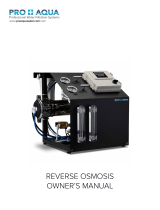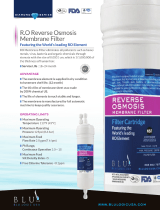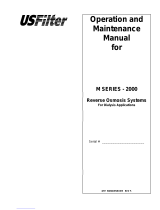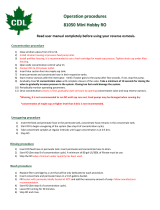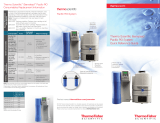Page is loading ...

OPERATIONS AND MAINTENANCE
M
A
NU
A
L
E4H Series Water Purification
M
a
c
h
in
e
s
16,000 GPD to 43,200 G
P
D
60.6 m
3
/day to 163.5
m
3
/
da
y
NOTICE
The enclosed materials are considered proprietary property of GE Water & Process Technologies. No assignments, either implied or expressed, of
intellectual property rights, data, know-how, trade secrets or licenses of use thereof are given. All information is provided exclusively for the addressee for
the purposes of evaluation and is not to be reproduced or divulged to other parties, nor used for manufacture or other means, or to authorize any of the
above, without the express written consent of GE Water & Process Technologies. The acceptance of this document will be construed as an acceptance of
the foregoing conditions. * Trademark of General Electric Company; may be registered in one or more countries.

Operations and Maintenance Manual
E4H Series Water Purification Machines
2
Table of Contents
1. DESCRIPTION ...................................................................................................................................................................... 5
1.1 Definitions .......................................................................................................................................................................... 5
1.1.1 Permeate Rate (Product Water Rate) [Qp] ...................................................................................................... 5
1.1.2 Concentrate Rate (Reject Rate) [Qc] .................................................................................................................. 5
1.1.3 Feed Rate [Qf ] .............................................................................................................................................................. 5
1.1.4 Reverse Osmosis (RO) ............................................................................................................................................... 5
1.1.5 Membrane Elements ................................................................................................................................................ 6
1.1.6 CIP ...................................................................................................................................................................................... 8
1.1.7 Average Pressure [PAVG] ....................................................................................................................................... 8
1.1.8 Concentration ........................................................................................................... .................................................... 8
1.1.9 Salt (Ionic) Passage .................................................................................................................................................... 8
1.1.10 Recovery ....................................................................................................................................................................... 8
1.1.11 Salt (Ionic) Rejection ................................................................................................................................................ 8
1.2 Flow Description .......................................................................................................................................................... 10
1.3 Machine Nomenclature ...................................................................................................... ...................................... 10
1.4 Economy (ECN) Model and Deluxe (DLX) Model Options .......................................................................... 11
1.4.1 ECN Model ................................................................................................................................................................... 11
1.4.2 DLX Model .................................................................................................................................................................. 12
1.5 Specifications for E-Series Machines ................................................................................................................. 13
1.5.1 Feed Water Specifications .................................................................................................................................. 13
1.5.2 Permeate Flow Rate ............................................................................................................................................... 14
1.5.3 Concentrate Flow Rate ......................................................................................................................................... 14
1.5.4 Operating Final Pressure ...................................................................................................................................... 14

Operations and Maintenance Manual
E4H Series Water Purification Machines
3
1.5.5 Pump .............................................................................................................................................................................. 14
1.5.6 RO Membrane Rejection ....................................................................................................................................... 14
2. INSTALLATION ............................................................................................................. ................................................... 16
2.1 Mounting .......................................................................................................................................................................... 16
2.2 Piping ................................................................................................................................................................................. 17
2.3 Electrical........................................................................................................................................................................... 17
2.3.1 ECN Electrical System ............................................................................................................................................ 17
2.3.2 DLX Electrical System ............................................................................................................................................ 18
3. PREPARATION AND START-UP................................................................................................................................ 19
3.1 Pretreatment for Water Purification .................................................................................................................. 19
3.2 Start-Up ............................................................................................................................................................................ 20
4. OPERATION AND MAINTENANCE .................................................................................................................................... 26
4.1 Daily Log Sheets ..................................................................................................................................................................... 26
4.2 Pre-Filter ..................................................................................................................................................................................... 26
4.3 Flushing ...................................................................................................................................................................................... 27
4.4 Cleaning ..................................................................................................................................................................................... 28
4.4.1 CLEANING PROCEDURE FOR DLX AND ECN
M
OD
EL
S
:
...................................................................... 28
4.5 Draining Machine for
S
t
o
r
age
/
S
h
ip
m
e
n
t
......................................................................................................... 30
4.6 Membrane
I
nst
a
lla
t
io
n
............................................................................................................................................... 30
4.7 Membrane
R
ep
la
c
e
m
e
n
t
........................................................................................................................................... 32
5. OPTIONAL
A
CCE
SS
O
R
I
E
S
................................................................................................................................................... 33
5.1 Standard
O
p
t
i
o
ns
.............................................................................................................................. ............................. 33
5.2 External
C
o
n
tr
o
ls
........................................................................................................................................................... 34
5.3 Filters and Water
S
o
f
t
e
ne
r
s
.................................................................................................................................... 34
5.4 Storage
T
a
nk
s
.................................................................................................................................................................. 34

Operations and Maintenance Manual
E4H Series Water Purification Machines
4
6.
TR
O
U
B
L
E
S
H
OO
T
I
NG
............................................................................................................................................................. 35
7. SPARE PARTS
L
I
S
T
.................................................................................................................................................................. 42
8. RETURN GOODS AUTHORIZATION (RGA)
PR
O
CE
D
U
RE
...................................................................................... 44
9.
W
A
RR
ANT
Y
/
G
U
A
R
ANTE
E
................................................................................................................................................... 46
9.1 Machine
W
a
rr
a
n
t
y
/
G
u
a
r
a
n
t
ee
.............................................................................................................................. 46
9.2 Desal* Membrane Element Workmanship
W
a
rr
a
n
t
y
............................................................................... 47
10. OPERATING
LO
G
S
................................................................................................................................................................ 50
10.1 START-UP
DA
T
A
............................................................................................................................................................. 50
10.2 DAILY LOG FOR GE WATER & PROCESS TECHNOLOGIES MEMBRANE
M
A
C
H
I
N
E
S
.................... 51
List of Tables
Table 1. 1: Flow Specifications for E4H Machines, 50-75%
R
e
c
o
v
e
r
y
.................................................................. 13
Table 1. 2: Feed Water Requirements
..................................................................................................................................... 13
Table 1. 3: Membrane Element Specifications –
AG4040F
*
......................................................................................... 15
Table 2. 1: Connection Schedule ................................................................................................................................................. 17
Table 6. 1: Troubleshooting Guide .................................................................................................................................................. 35
List of Figures
Figure1. 1: Normal vs. Crossflow Filtration ............................................................................................................................... 6
Figure1. 2: Membrane Element with Interconnectors ......................................................................................................... 7
Figure1. 3: Cross-Sectional View of Membrane Element ................................................................................................... 7
Figure1. 4: Principle of Operation .................................................................................................................................................. 9

Operations and Maintenance Manual
E4H Series Water Purification Machines
5
1. DESCRIPTION
Your E-Series reverse osmosis (RO) machine is a durable piece of equipment which, with proper
care, will last for many years. These instructions give operation and maintenance details vital
to the sustained performance of the machine. Please read this manual completely before
operating your machine.
1.1 Definitions
The operating definitions provided below will help you further understand
y
o
ur
machine and
this manual.
1.1.1 Permeate Rate (Product Water Rate) [Qp]
The flow rate of
purif
ied water, which has passed through the membrane and out of the
membrane
element
, expressed in gal/min (gpm) or gal/hr (gph) or liter/min (lpm) or cubic
meters/hour (m
3
/h). Specified permeate rates are based on a feed water temperature of 77 °F
(25°C). Permeate rate will vary with temperature.
1.1.2 Concentrate Rate (Reject Rate) [Qc]
The flow rate of water containing rejected solids to drain in gpm or gph (lpm or m
3
/h).
1.1.3 Feed Rate [Qf ]
The flow rate of incoming water in gpm or gph (lpm or m
3
/h). Feed water rate equals permeate
rate plus concentrate rate.
1.1.4 Reverse Osmosis (RO)
Reverse osmosis is the separation of one component of a solution from another component by
means of pressure exerted on a semipermeable membrane. In other words, reversing the
natural passage of a liquid from a concentrated solution to a more dilute solution by using
external pressure. Removal of ionic, organic, and suspended /dissolved impurities occurs
during the RO process. Unlike a filter, which separates by “normal” filtration, the membrane
element separates using a process called cross flow filtration. Feed water solution is
separated in to two streams, permeate and concentrate, and collected from both sides of the
membrane. A semipermeable RO membrane, under sufficient pressure, allows passage of
purified
water while rejecting and concentrating dissolved and suspended solids.

Operations and Maintenance Manual
E4H Series Water Purification Machine
6
Figure1. 1: Normal vs. Crossflow Filtration
1.1.5 Membrane Elements
Membrane elements are the key to reverse osmosis. Interleaved layers of semipermeable
membrane, spacer and permeate carrier spiraled around a central permeate tube make up
the
element
. The spacer allows for movement of the concentrate past the membrane, and
the permeate carrier carries the purified water out of the membrane
element
. GE Water &
Process Technologies manufactures a patented spiral wound membrane element with a
turbulent flow design. This membrane module collects the purified water within the central
tube, the permeate tube.
The E4H RO machine utilizes between 9 and 24 membrane
elements.

Operations and Maintenance Manual
E4H Series Water Purification Machine
7
Figure1. 2: Membrane Element with Interconnectors
Figure1. 3: Cross-Sectional View of Membrane Element

Operations and Maintenance Manual
E4H Series Water Purification Machine
8
1.1.6 CIP
The abbreviation for clean-in-place.
1.1.7 Average Pressure [PAVG]
(
P
Primar
y
+ P
Final
)
2
1.1.8 Concentration
Concentration equals the Total Dissolved Solids (TDS) concentration of a solution expressed
as parts per million (ppm) or conductivity (microSiemens/cm).
C
f
= Feed Concentration
C
p
= Permeate Concentration
C
c
= Concentrate Concentration
C
avg
= Average Concentration in Machine
1.1.9 Salt (Ionic) Passage
The percent of dissolved salts passed through the membrane or 100% minus rejection.
1.1.10 Recovery
Permeate rate divided by feed rate, expressed as a percentage. For example, 33% recovery
means that for a given feed rate, 33% is produced as purified water (permeate).
1.1.11 Salt (Ionic) Rejection
The percent of dissolved salt rejected by the membrane, calculated from an average
concentration over the membrane.

Operations and Maintenance Manual
E4H Series Water Purification Machine
9
An example of how to calculate salt rejection and recovery is given below.
Figure1. 4: Principle of Operation
Given the system case in the figure above:
Average Concentration,
2
CC
C
cf
Avg
TDS 237.5mg/L
2
375mg/L100mg/L
%5.96100
237.5mg/L
8.3mg/L237.5mg/L
100
C
CC
Rejection
Avg
pAvg
%5.3100
237.5mg/L
8.3mg/L
C
C
Passage
Avg
p
%75100
24gpm
18gpm
100
Q
Q
Recovery
f
p

Operations and Maintenance Manual
E4H Series Water Purification Machine
10
1.2 Flow Description
The feed water passes through a replaceable 5-micron cartridge filter, which removes bulk
suspended solids. Filtered water then flows to the inlet control valve.
This solenoid-controlled diaphragm valve is wired to the on/off switch and opens when the
machine is turned on, allowing water to flow to the pump
inlet.
When the machine is turned
off, the valve closes, preventing non-turbulent flow through the membrane elements, which
would lead to shortened membrane life.
The pump feeds water to the membrane housings arranged in parallel and serial
combinations. A throttling valve is included on the pump discharge for manual adjustment
of the pump pressure. The direction of water flow is indicated by an arrow on each housing.
Water is separated by the membrane within the membranes and leaves the housings in two
streams: permeate and concentrate.
Permeate from each membrane housing is collected in a common manifold. The permeate
then flows through a flow meter and to the outlet point of the machine.
The concentrate leaves the last membrane housing and flows to the flow control center
(recycle/concentrate manifold). At this point, the recycle valve channels a predetermined
amount of concentrate into the pump inlet. Recycle increases recovery while maintaining
adequate cross-flow through the membranes. The other two ports of the flow control center
lead to the concentrate valve and final pressure gauge. The concentrate valve has three
functions: It controls the amount of concentrate flowing to the drain; it controls the pressure
within the machine; and it helps control the system recovery. A feed flush solenoid is added
to the flow control center with an additional tee. The concentrate then flows through a flow
meter and to the outlet point of the machine.
1.3 Machine Nomenclature
E-Series water purification machines are numbered in such a way as to indicate the
permeate flow you can expect from the machine and other specifications.

Operations and Maintenance Manual
E4H Series Water Purification Machine
11
Example: RO,E4H-21K-DLX, 460, 6, 50-75
• RO indicates the machine is a reverse osmosis machine.
• E4H indicates the machine series (E) and 4-inch housings/membrane elements
• H indicates horizontal membrane element housing configuration
• 21K indicates the rated permeate flow in thousands of gallons per day at 77°F (25°C),
i.e. 21K = 21,000 gallons per da
y
• DLX indicates the deluxe model and ECN indicates the economy model
• 460 indicates 460 VAC, 3-phase voltage to starter. Standard models offer 460 VAC, 60
Hz, 3-phase, 230 VAC, 60 Hz, 3-phase, and 380 VAC, 50 Hz, 3-phase.
• 6 indicates 60 Hz operation, (50 Hz operation is also available and is indicated b
y
a 5 in
place of the 6.
• 50-75 indicates a recovery range of 50 to 75%.
1.4 Economy (ECN) Model and Deluxe (DLX) Model Options
1.4.1 ECN Model
E-Series ECN model water purification machines have all the features necessary for safe,
continuous production of high purity water. This assumes good quality feed water, adequate
pretreatment and regular operator maintenance, each shift or dai
ly
, to the operation of the
sy
stem.
• 50% to 75% recover
y
• Multi-stage centrifugal pump, SS construction (stainless steel castings with Noryl*
Stages)
• Base model electrical package includes NEMA-1 enclosure with a 110 VAC, 60 Hz or
220 VAC, 50 Hz single-phase control circuit; applies to all ECN models
• Automatic inlet shutoff valve

Operations and Maintenance Manual
E4H Series Water Purification Machine
12
• Pre-filter housing and 5-micron cartridge filter
• Pre-filter, post-filter, primary and final pressure gauges
• Concentrate and permeate flow rotameters
• Pump throttling valve
• Digital conductivity monitor, panel-mounted, for permeate quality monitoring
• Feed flush System - programmable, automated high-velocity membrane flushing for
the longest membrane life; set at the factory and adjustable in the field
• Gauges, valves and rigid piping of stainless steel or plastic
• Fiberglass reinforced plastic (FRP) membrane housing, with Noryl end caps
• Stainless steel concentrate and recycle valves
• All components in contact with the purified water (permeate) are either FDA-
acceptable plastic (nylon, Noryl, polypropylene, PVC) or stainless steel materials.
• All high pressure fittings are 304 stainless steel.
• Alarms included: low inlet pressure and motor fault
1.4.2 DLX Model
The DLX package contains all of the above ECN standard features along with an AccuTrak®
RO solid state controller.
• Electrical package includes AccuTrak® RO controller
• Chemical dosing system for antiscalant or pH adjustment
• Clean-In-Place (CIP)
sy
stem
• Digital flow meter and conductivity sensor
• Analog pH sensor on inlet
• Alarms included: low inlet pressure, high permeate pressure, high/low inlet pH, high
temperature, high permeate conductivity, f ill-time exceeded, and motor fault

Operations and Maintenance Manual
E4H Series Water Purification Machine
13
1.5 Specifications for E-Series Machines
The machine flow specifications listed in Table 1.1 below are based on 77°F (25°C) and 2,000 ppm
NaCl.
Table 1. 1: Flow Specifications for E4H Machines, 50-75%
R
e
c
o
v
e
r
y
M
od
e
l
E
4
H-
16
K
E
4
H-
21
K
E
4
H-
27
K
E
4
H-
38
K
E
4
H-
43
K
U
nit
s
gpm (m
3
/h) gpm (m
3
/h) gpm (m
3
/h) gpm (m
3
/h) gpm (m
3
/h)
Pe
r
meate
R
a
t
e
11.2 (2.56) 15 (3.4)
18.8 (4.3)
26.2 (5.9) 30 (6.8)
C
once
nt
r
a
t
e
R
a
t
e
11.2-3.7
(2.5-0.8)
15-5
(3.4-1.1)
18.8-6.3
(4.3-1.4)
26.2-8.7
(5.9-2.0)
30-10
(6.8-2.3)
Feed
R
a
t
e
22.4-14.9
(5.1-3.4)
30-20
(6.8-4.5)
37.6-25.1
(8.5-5.7)
52.4-34.9
(11.9-7.9)
60-40
(13.6-9.1)
1.5.1 Feed Water Specifications
The feed water requirements stated in the following table must be met to ensure quality
permeate and extended membrane element life.
Table 1. 2: Feed Water Requirements
Te
m
p
e
r
a
t
u
r
e
Typical: 50-85°F (10-29°C)
Maximum: 32-104°F (0-40°C)
Inlet
Pr
e
ssu
r
e
Minimum 30 psig (2.1 bar)
Maximum 60 psig (4.1 bar)
Chlorine (continuous
f
ee
d
)
0 ppm
Operating
p
H
For soft water (less than 1 grain per gallon (gpg) or 17 mg/L hardness),
acceptable pH is 4.0-11.0.
For unsoftened water contact factory with water analysis, acceptable pH
is 5.5-6.0.
For short term (cleaning) a pH range of 2-12 is acceptable.
Silt Density Index
(
S
D
I
)
Less than or equal to 3 to minimize membrane fouling and extend cleaning
intervals. Refer to ASTM standard D4189.

Operations and Maintenance Manual
E4H Series Water Purification Machine
14
1.5.2 Permeate Flow Rate
Stated in Table 1.1 above and on the machine serial number label (assumes no permeate
backpressure, 2000mg/L TDS maximum feed concentration, and rated temperature).
To estimate permeate output with backpressure, use the formula below:
Maximum permeate backpressure is 80 psig (5.5 bar).
Pressure) (Operating
re)Backpressu (Permeate-Pressure) (Operating
Label) on Flow (Permeate
1.5.3 Concentrate Flow Rate
Stated in Table 1.1 and factory set as stated on serial number label.
1.5.4 Operating Final Pressure
Minimum - 200 psig (13.8 bar)
Maximum - 235 psig (16.2 bar)
1.5.5 Pump
Multi-stage centrifugal; approximate primary operating pressure of 190 psig (13.1
bar) excluding line pressure.
1.5.6 RO Membrane Rejection
E4H reverse osmosis machines use GE fiberglass reinforced plastic (FRP) covered
AG4040F membrane elements. For ordering information refer to the attached Spare
Parts List. See Table 1.3 below for details.

Operations and Maintenance Manual
E4H Series Water Purification Machine
15
Table 1. 3: Membrane Element Specifications –
AG4040F
*
Outer Cover
M
a
t
e
r
ia
l
FRP
Typical Ionic Rejection
(
T
D
S
)
*
99.0 – 99.5%
Nominal Permeate Flow Rate at 225
p
s
i
2,200 gpd
(8
.
3m
3
/
da
y
)
Typical Feed Water Temperature
R
a
ng
e
50 – 85°F (10-29.4C)
Maximum
T
em
p
e
r
a
t
u
r
e
122°F (50C)
pH
R
a
ng
e
4.0 – 11.0
Chlorine
T
o
le
r
a
n
c
e
< 0.01 ppm
Active Membrane
Ar
e
a
85 ft
2
(7.9 m
2
)
*Specification is based on a 2,000 mg/L NaCl solution at 225 psi (1,551 kPa) operating pressure, 77°F
(25°C), pH 7.5 and 15% recovery. Individual flux may vary +25%/-15%. Average salt rejection after a
minimum of 24 hours of continuous operation.

Operations and Maintenance Manual
E4H Series Water Purification Machine
16
2. INSTALLATION
2.1 Mounting
E4H Series machines are equipped with a stand-alone frame, which supports the machine. At
least 45 inches (114 cm) of space should be allowed on each end of the membrane element
housings for removal and loading of membrane elements. If 45 inches (114 cm) are not
available, the entire membrane element housing may need to be removed for membrane
element replacement.
WARNING!!
A vacuum breaker must be installed at the highest point along the
concentrateline.Failuretodosomaycauseavacuumtoformwithinthis
line after shutdown. This may in turn cause numerous problems,
including biological fouling,water hammer, leaks from RO housing side‐
ports,andthe
siphoningoftreatmentchemicals.
WARNING:
Connect the concentrate line to the RO machine’s concentrate outlet. A vacuum breaker must
be installed at the highest point along the concentrate line. This provides an atmospheric
break upstream from where the flow enters the drainage system. For systems which include
multiple RO machines, install check valves along each machine’s concentrate line prior to
connecting the lines to a common manifold.

Operations and Maintenance Manual
E4H Series Water Purification Machine
17
2.2 Piping
The E4H comes with threaded NPT fittings. A CIP system is supplied with the DLX Model E4H.
Table2.1:
Connection Schedule
M
od
e
l
E
4
H-
16
K
E
4
H-
21
K
E
4
H-
27
K
E
4
H-
38
K
E
4
H-
43
K
I
n
le
t
1.5-inch 1.5-inch 1.5-inch 1.5-inch 1.5-inch
Pe
r
me
a
t
e
1.0-inch 1.0-inch 1.0-inch 1.0-inch 1.0-inch
C
o
n
c
e
n
tr
a
t
e
1.0-inch 1.0-inch 1.0-inch 1.0-inch 1.0-inch
CIP Drain (DLX
o
n
ly
)
1.5-inch 1.5-inch 1.5-inch 1.5-inch 1.5-inch
2.3 Electrical
The DLX and ECN E-Series models are supplied with a single-phase, 110 VAC 60 Hz or 220 VAC
50 Hz control circuit. Refer to your machine electrical single-line drawing for dedicated circuit
requirements.
The electrical system control circuit is separate from the motor voltage. Therefore, two supply
voltages are required for electrical wiring in the field, the control circuit voltage and a separate
three-phase motor voltage. All field wiring must comply with applicable local and national
electric codes.
2.3.1 ECN Electrical System
• A panel mounted power on/off switch is provided on the electrical enclosure.
• Connect the control circuit power cord to 110 VAC, 60 Hz, or 220 VAC, 50 Hz, single
phase power.
• Connect the three-phase power in to the motor starter 3-pole contacts (230/460 VAC
or 380 VAC as appropriate). Ensure that the power supplied matches the motor voltage and
phase requirements. Check the tag (located on the motor starter) that indicates the factory
wiring. A separate, fused disconnect for the motor wiring is required with proper protection for
the HP and amp draw of the RO and CIP motors (provided by others). Please refer to single-
line drawing for further detail.

Operations and Maintenance Manual
E4H Series Water Purification Machine
18
2.3.2 DLX Electrical System
• The DLX series E4H’s include the AccuTrak® RO solid state controller. The AccuTrak
includes a menu screen for selecting the operation mode of the RO. The RO must be in either
“Auto” or “Hand” position for the high pressure pump to start.
• Connect the control circuit power to 110 VAC, 60 Hz, or 220 VAC, 50 Hz, single phase
power.
• Connect the three-phase power in to the motor starter 3-pole contacts (230/460 VAC
or 380 VAC as appropriate). Ensure that the power supplied matches the motor voltage and
phase requirements. Check the tag (located on the motor starter) that indicates the factory
wiring. A separate, fused disconnect for the motor wiring is required with proper protection for
the HP and amp draw of the RO and CIP motors (provided by others). Please refer to single-
line drawing for further detail.

Operations and Maintenance Manual
E4H Series Water Purification Machine
19
3. PREPARATION AND START-UP
3.1 Pretreatment for Water Purification
All systems will operate most efficiently on filtered water with a pH of less than 6.5 and a Silt
Density Index (SDI) of 3 or below. If the machine is operated on higher pH water, other forms of
pretreatment may be necessary. A water analysis prior to start-up of the machine is required.
To minimize the chances of calcium carbonate, calcium sulfate, or other salt precipitation on
the membrane, GE Water & Process Technologies strongly suggests that each application and
water condition be evaluated so that specific recommendations can be made to ensure
continuity of the membrane warranty. Data from the water analysis is processed with a
computer program analysis to determine if potential problems exist. If the machine is to be run
at a different location than was originally intended, a new water analysis is required for
warranty consideration and should be sent to GE Water & Process Technologies for review and
recommendations for operation of the machine.
Before entering the machine, the feed water must be filtered to 5-microns.
TFC membrane feed water must not contain the following chemicals or permanent loss of
rejection and/or permeate flow may result:
• Free chlorine
• Formalin (until after a membrane has been run for 24 hours; thereafter, 0.5%-
formaldehyde may be used as a biocide)
• Iodine compounds
• Quaternary germicides
• Cationic surfactants
• Detergents containing non-ionic surfactants
Cleaners not approved by GE Water & Process Technologies
A water softener should not regenerate while the machine
is
running unless safeguards are used to be sure the machine
is
operated on softened water during
r
e
g
e
ne
r
a
t
io
n
.
Caution!

Operations and Maintenance Manual
E4H Series Water Purification Machine
20
3.2 Start-Up
NO
TE
If your machine is provided with the membranes installed in
the housings, proceed to step 1. If your machine is
p
r
o
v
i
d
e
d
with the membranes in shipping boxes, you must load
t
he
membranes in the housings prior to starting the machine.
F
o
r
membrane loading
instructions,
skip to Section 4.6.
U
p
o
n
completion of membrane
installation,
return to section 3.2
t
o
continue your start-up
p
r
o
c
e
d
u
r
e
.
1. Re-check the function and integrity of your pretreatment equipment. Ensure that
your water softener, activated carbon filters and iron filters (where applicable) have
been leak-checked, backwashed, and thoroughly rinsed for service before starting
up your RO unit.
2. Attach the feed water pipe to the inlet of the machine.
3. Check for leaks at all connection points.
4. Turn on the feed water gradually and check for leaks in the inlet piping. No flow
should go through the machine while the power is off and the inlet solenoid is in the
closed position.
When the machine is off, there should never be flow
t
h
r
o
u
g
h
the
machine. Flow through the machine when it is off
c
a
n
damage the
membranes, and the inlet solenoid m u s t b e
r
e
pa
i
r
e
d
NO
TE
5. Attach tubing from permeate and concentrate outlet points, and run the tubing to
drain.
6. Ensure that you have made provisions for both voltages required to operate
y
our
machine. The machine requires two power sources: (1) the high voltage for the motor
operation, and (2) the control circuit power supply. The motor electrical service must be
field-wired directly into the motor starter on the machine. Bring your motor service
wiring to the 3-pole contacts on the motor starter. Check the voltage label to ensure
that you have brought the correct voltage to the starter.
7. Be sure the power to the motor starter is de-energized.
/
